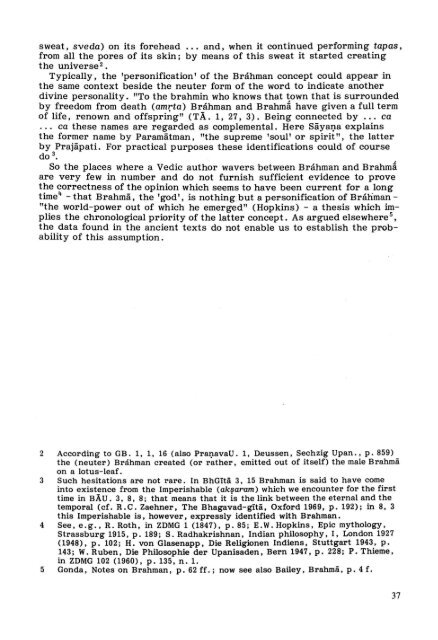Prajapati's relations with Brahman, Brhaspati and Brahma - DWC
Prajapati's relations with Brahman, Brhaspati and Brahma - DWC
Prajapati's relations with Brahman, Brhaspati and Brahma - DWC
Create successful ePaper yourself
Turn your PDF publications into a flip-book with our unique Google optimized e-Paper software.
sweat, sveda) on its forehead ... <strong>and</strong>, when it continued performing tapas,<br />
from all the pores of its skin; by means of this sweat it started creating<br />
the universe 2 •<br />
Typically, the 'personification' of the Bráhman concept could appear in<br />
the same context beside the neuter form of the word to indicate another<br />
divine personality. "To the brahmin who knows that town that is surrounded<br />
by freedom from death (amrta) Bráhman <strong>and</strong> Brahmä have given a full term<br />
of life, renown <strong>and</strong> offspring" (TÄ. 1, 27, 3). Being connected by ... ca<br />
. .. ca these names are regarded as complemental. Here SäyaJ}.a explains<br />
the former name by Paramätman, "the supreme 'soul' or spirit", the latter<br />
by Prajäpati. For practical purposes these identifications could of course<br />
do 3.<br />
So the places where a Vedic author wavers between Bráhman <strong>and</strong> Brahmä<br />
are very few in number <strong>and</strong> do not furnish sufficient evidence to prove<br />
the correctness of the opinion which seems to have been current for a long<br />
time" - that Brahmä, the 'god', is nothingbut a personificationof Bráhman<br />
"the world-power out of which he emerged" (Hopkins) - a thesis which implies<br />
the chronological priority of the latter concept. As argued elsewhere s ,<br />
the data found in the ancient texts do not enable us to establish the probability<br />
of this assumption .<br />
2 According to GB. 1, 1, 16 (also PraQavaU. 1, Deussen, Sechzig Upan. , p. 859)<br />
the (neuter) Bráhman created (or rather , emitted out of itself) the male Brahmä<br />
on a lotus-Ieaf.<br />
3 Such hesitations are not rare. In BhGïtä 3, 15 <strong><strong>Brahma</strong>n</strong> is said to have come<br />
into existence from the Imperishable (ak~aram) which we encounter for the first<br />
time in BAu. 3, 8, 8; that means that it is the link bet ween the eternal <strong>and</strong> the<br />
tempora! (cf. R.e. Zaehner, The Bhagavad-gïtä, Oxford 1969, p. 192); in 8, 3<br />
this Imperishable is, however, expressly identified <strong>with</strong> <strong><strong>Brahma</strong>n</strong>.<br />
4 See, e.g. , R. Roth, in ZDMG 1 (1847), p. 85; E.W. Hopkins, Epic mythology,<br />
Strassburg 1915 , p. 189; S. Radhakrishnan, Indian philosophy, I, London 1927<br />
(1948), p. 102; H. von Glasenapp, Die Religionen Indiens, Stuttgart 1943, p.<br />
143; W. Ruben, Die Philosophie der Upanisaden, Bern 1947, p. 228; P. Thieme,<br />
in ZDMG 102 (1960), p. 135, n. 1.<br />
5 Gonda, Notes on <strong><strong>Brahma</strong>n</strong>, p. 62 ff.; now see also Bailey, Brahmä, p. 4 f.<br />
37
















